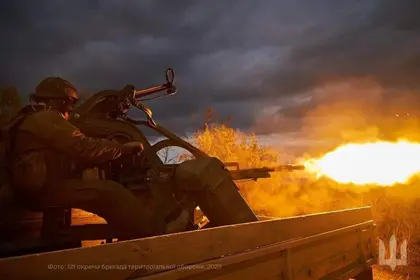Ukrainian Marines holding a tenuous bridgehead on the left bank of the Dnipro River were slugging it out against Russian defenses on Monday, trading artillery strikes and countering Kremlin air strikes with mass drone raids, officials and open sources said.
Serhiy Bratchuk, head of the Odesa regional defense command, in comments televised nationally on Sunday evening, said that units dug in at the main Ukrainian enclave around the village of Krynky were holding their positions under regular Russian air and artillery attacks that had leveled most buildings in the vicinity – but Marine fortifications were still capable.
JOIN US ON TELEGRAM
Follow our coverage of the war on the @Kyivpost_official.
Elements of four Ukrainian Marine brigades began small boat crossings of Ukraine’s biggest waterway on Oct. 14. By early November, Russian and Ukrainian military information platforms were widely reporting Ukrainian troops had grabbed and dug into two toeholds, one near the village of Pishchanikva and the other near the village of Krynky.
The first official Ukrainian acknowledgment of the risky amphibious operation was made public on Nov. 17. According to open-source reports, the relative size of the Ukrainian force across the river remains relatively small with 200-300 men at either bridgehead.
Bratchuk said the most intense combat in the sector currently is in the vicinity of Krynky. Little terrain is changing hands but bombardments on both sides are intense, and currently, the Ukrainian objective is to establish fire dominance by using the Armed Forces of Ukraine’s (AFU), longer-ranged, more accurate artillery to force Russian guns and howitzers away from the Marine positions.

Diane Francis Interviews Mikhail Zygar, Yaroslav Trofimov on Prospects of Russia’s War on Ukraine
Light Ukrainian bombardment weapons have transferred to the left bank to help, and Marine patrols and drone raids have crossed Russian lines to hit Kremlin rear area targets, he said.
“The Marines are not only holding, but at present we can speak of counter-battery battles, not just firing from the right bank, but from the left bank as well,” Bratchuk said. “Behind-the-lines raids, sabotage, attacks against Russian troops and equipment… It’s possible to single out the 501st (Marine) Battalion which (used drones and) destroyed several (Russian) vehicles carrying military materiel along the road Oleshki-Nova Kakhovka.”
Bratchuk said Marines have suffered losses but claimed the Krynky bridgehead is still viable. A close hold on information from the bridgeheads is necessary to protect troops, but, Russian official sites and military information platforms on Monday acknowledged the Ukrainian troop presence around Krynky but claimed Kremlin artillery and air strikes are inflicting heavy casualties on the Ukrainian Marines and slowly grinding down their positions. Moscow-supported “military correspondent” Boris Rozhin contradicted a Bratchuk claim that Ukrainian troops had made minor advances around Krynky.
"Russia is trying to destroy the places in Krynky our Marines hold while we keep targeting their supplies. For example the 501st Marine Batallion, which destroyed several enemy trucks with ammunition. But this doesn't go without losses. Events are taking place now, and will take… pic.twitter.com/Gf7fqOzfLY
— NOELREPORTS 🇪🇺 🇺🇦 (@NOELreports) November 20, 2023
“Russian Federation troops pushed the enemy back a little around the village Krynky, but it wasn’t possible to knock him out of the village he had already captured,” Rozhin said. “The enemy is continuing to replace his ongoing losses with continuing reinforcements by small boat across the Dnipro. Russian Federation troops, for their part, are increasing destructive fire on the Ukrainian forces. In the last several days AFU losses in dead, wounded and prisoners has increased substantially.”
Kyiv Post was unable to substantially confirm Bratchuk’s and Rozhin’s conflicting claims about Ukrainian losses in the bridgehead. Practically all sources reported intense artillery fires and, from the Ukrainian side, multiple drone attacks against Russian behind-the-line targets.
Both Russian and Ukrainian military information platforms reported Russian Air Force jets performed close to 20 air strikes against Marine positions over the weekend. Russian commanders also deployed at least one TOS-1A Solntsepek, a heavy armored vehicle firing incendiary rockets at close range, against Ukrainian defenses near the village of Krynky, and some Russian information platforms on Sunday posted a video of one system in action.
The Russian information platform Dva Major, a patriotic Russian Telegram channel sometimes critical of the Kremlin top command, on Sunday published video of a converted Ukrainian agricultural drone dropping an explosive on a TOS-1 and destroying it in the Kherson sector. The report said the Ukrainian strike took place “several days ago.”
More anecdotal evidence supporting Ukrainian claims of intense and sometimes successful strike drone operations in the Kherson sector appeared over the weekend.
The Ukrainian unit Grifon501, a drone reconnaissance and attack unit long associated with 501st Battalion 36th Marine Brigade published video images of an explosives-toting drone hitting and setting on fire military vehicles. The military information platform Militariy reported a hobby drone modified by Marine operators to carry an RPG-7 anti-tank rocket warhead was used.
Miltariy in a Nov. 19 article said the strike took place at a road intersection some 7-8 kilometers (4-5 miles) inland from the Dnipro River. Kyiv Post researchers reviewing drone footage confirmed the grid location of the strike to be at 46.71344928546432, 33.156520773091465.
Robert “Madyar” Brovdy, head of a leading crowd-sourced strike and reconnaissance drone organization operating in the Kherson sector, in a Sunday Telegram post confirmed Marines were holding their positions and claimed that Ukrainian volunteers and military drone operators had achieved near air superiority in support of the Marine bridgeheads. Multiple video clips posted by Brovdy and other Ukrainian military news sources showed hobby drones hitting Russian military vehicles or soldiers, reportedly in the Kherson sector. Supply to the Ukrainian footholds was still sketchy and carried on a limited number of inflatable boats shuttling back and forth across the river, Brovdy said.
Ukrainian military platforms on Sunday widely reported a Ukrainian precision-guided munition demolished an administrative building at an abandoned Soviet-era rural airfield reportedly used by Russian troops in Kherson sector as a barracks. Reports conflicted on the type of weapon used, with some sources crediting the strike to a HIMARS precision-guided rocket, and others saying a JDAMS-ER glide bomb caused the damage.
Video showed the munition’s warhead detonating after penetrating the roof, and subsequent images recorded by a long-range drone showed the structure mostly flattened and military personnel picking through the debris. Kyiv Post researchers confirmed the building’s location at 46.424709416865745, 33.056088966842005, near the village of Tarasivka. The military information Telegram channel Nikolaevskiy Vanek reported the strike took place on Nov. 17.
Ukraine’s Army General Staff (AGS) on Saturday claimed Marines deployed to the left bank village of Krynky took new ground and that in that sector “around 20 Russian occupation troops from the Russian 144th Motor Rifle Brigade deserted and evacuated their positions against orders.”
There was no independent confirmation of the Ukrainian claim.
The most punishing Ukrainian strike against Russian forces in the Kherson sector, following the river crossing, according to open-source reports took place Nov. 10 near the village of Hladkivka, when a Ukrainian HIMARS precision-guided rocket strike hit a vehicle column from Russia’s 35th Separate Motor Rifle Brigade. At least two long-range weapons struck in the vicinity of the truck column and killed at least 76 soldiers, Russian military information channels said.
You can also highlight the text and press Ctrl + Enter









